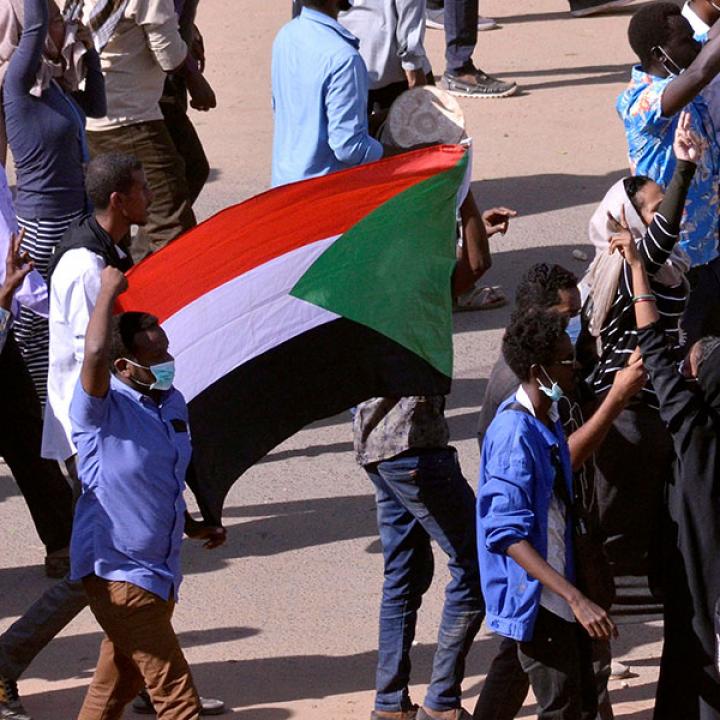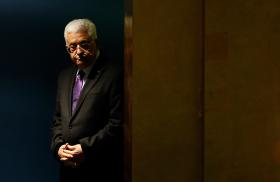
- Policy Analysis
- Fikra Forum
Generational Conflict and Forging the Future in the Current Sudanese Movement

The December 25th movement in Sudan, with its ongoing protests, should not be viewed as a political movement so much as the movement of a new generation earnestly questioning what lies in their future. Despite the prevalence of political and economic analysis on the crisis, this aspect of a generational shift is no less vital to understanding its underlying factors.
One major element of the protests that is immediately evident is that the majority of those who are participating are young people—ranging from sixteen to thirty-five years at most. These protesters are a mix of students, graduates, and professionals, but their age is often what distinguishes them. That young protesters make up much of this movement should come as no surprise; the latest United Nations population prospects report suggests that there are approximately 25 million Sudanese between zero and twenty-four in a country of about 43 million, with this number predicted to continue rising in the coming years. Given these numbers, there is no doubt that Sudan’s youth cohort is the backbone of the state and its future. This makes the protesters’ message that the current government no longer represents the hopes of this broad category of the Sudanese people a particularly resonant one.
Historically, there has been a strong correlation between countries’ youth cohorts and political transformations, for better or worse. Youth emerged as the fundamental element behind Nazi Germany’s vision of geopolitical expansion, while in China, young people formed the foundation of the demonstrations demanding democratic reforms that culminated in the Tiananmen Square massacre in central Beijing. More recently, young people were also the mainstay of the Arab Spring revolutions in Egypt, Tunisia, and other Arab countries.
Studies on the relationship between a rising youth population and the prevalence of political demonstrations suggest that this type of upheaval occurs for a number reasons, including high enthusiasm and a desire for change and experimentation among youth. Also notable is that this cohort is less likely to see political compromise as a viable alternative, a trait visible in the sharpness of youth rhetoric that highlights the choice between victory or defeat rather than potential alternatives.
However, Sudanese youth protesters are also naturally driven by problems unique to Sudan. There is a structural weakness in the government that has raised young people’s doubts about its ability to provide a better future. The economic challenges that rocked the nation have continued to worsen for over three years. Add to this a collapse in managing certain goods and services. In recent years, the concept of the state has been limited to some administrative functions, though the previous breadth of the state led Sudanese, especially young people, to become dependent on state institutions for many regular aspects of life. Youths rely on the state to provide cheap goods, employment, and educational opportunities. And as young people’s dependency on the state increases, so too does their likelihood of protesting against the state when it falls short of what these young adults perceive as a responsibility toward them.
More specifically, the academics Nazli Choucri, Richard G. Braungart, and E. A. Winckler have argued that the unemployment rate among working youth is one of the greatest sociopolitical threats to any regime. The sociologist Jack A. Goldstone adds that a major increase in the number of educated youths often precedes political upheaval in nations. Likewise, increasing rates of urbanization build opportunities for a large number of the same age group to congregate in cities. These forms of economic upheaval have all been visible in Sudan. Furthermore, more politically closed regimes also foment youth protest, although an increase in freedoms within democratic systems can also lead towards youth political protests.
Although the movement’s main placards call for the overthrow of the regime, its underlying message is that Sudanese youth protesters are calling to topple a regime of the elders who have been in control of the country’s affairs since independence. A dream has now begun to take shape for a state based on and largely governed by youth, which is now a basic demand of the popular movement in Sudan. This movement reflects earlier global youth movements in Europe and America and echoes recent political shifts in other parts of Africa—notably with the rise of Abiy Ahmed in Ethiopia and Yusuf al-Shahid in Tunisia.
Back in Sudan, the movement has come as a surprise to the country’s political class, whether in government or opposition. Although some political parties have joined the protests, they will face the same difficulty as the government in absorbing the major drivers of the movement, as young people will emerge as a threat to any and all representatives of the old political establishment, including opposition figures. This is particularly the case since the December 25th movement is not a movement of politicized or politically-oriented youth. It is instead attracting large groups of youth who had previously faced barriers keeping them out of politics. This new political enfranchisement is perhaps the greatest accomplishment of the youth movement, and if built and developed, may lead to mass political participation becoming part of the broader Sudanese culture. This may provide the chance for political representatives to be drawn from all walks of life rather than Sudan’s traditional political professionals.
Because it is driven by Sudanese youth, the December 25 movement represents a historic opportunity to rebuild Sudanese state institutions, move beyond the all-encompassing concept of the nation state, and reform the Sudanese state’s crisis-ridden political establishment. However, the movement presents also a major challenge for the young people of Sudan—protesters must invest in the current spirit of reform to overcome historical institutions without falling into the crises that have characterized the past, such as rushing to build a top-down democracy or moving forward without consulting the traditional majority outside of the country’s major cities. Here, the biggest responsibility to avoid these potential pitfalls lies with Sudan’s young elite. They are in the most likely position to obtain positions of political influence and must be aware of the complexities of the moment and the necessity of consolidating the movement so that the youth do not lose their strategic advantage.



